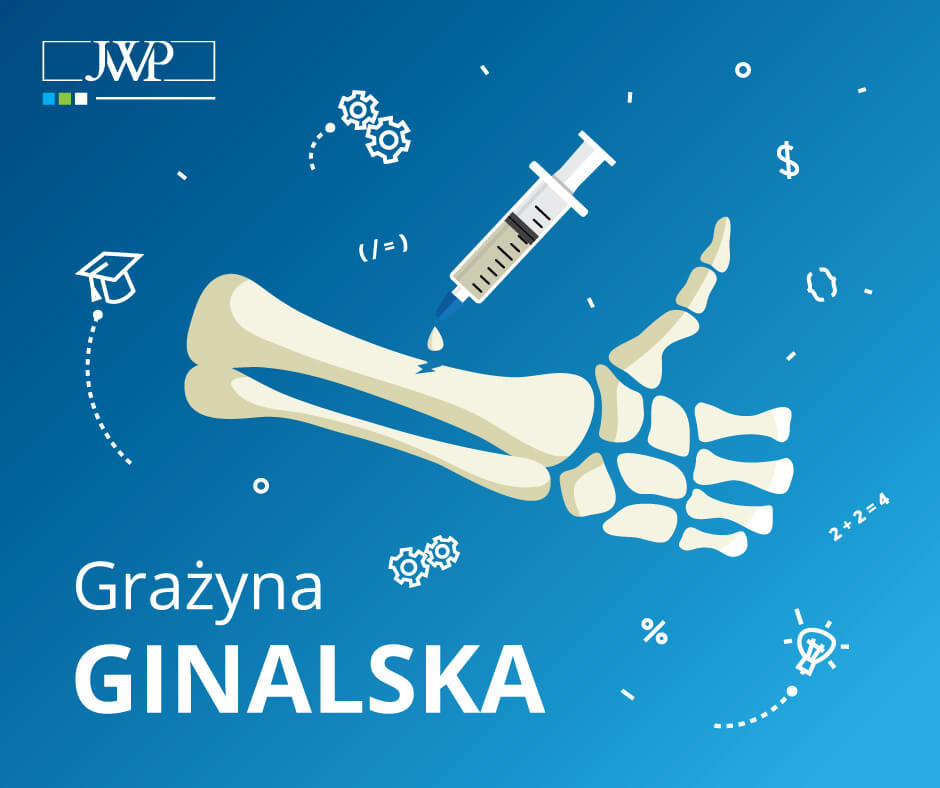A unique implantation material, popularly known as “artificial bone”, created by a team headed by Professor Grażyna Ginalska heralds a revolution in surgery. The material does not cause any allergies and merges perfectly with the patient’s real bone. Moreover, it provides hope that the whole healing process can be accelerated in the future.
Progress takes time. Professor Grażyna Ginalska did not regret taking on her goal. Many years of painstaking research led her to the creation of a biomaterial that has a very similar chemical composition to the natural bone of a human being. But how did the history of a such breakthrough invention in the field of surgery begin?
As a matter of necessity
The invention of the artificial bone is the result of Grażyna Ginalska’s interest in the application of medical research in practice and the need that arose from the field of orthopaedics. In one interview, the professor revealed how work on the artificial bone began: “Some orthopaedists came to me and said that they needed a material that would be more practical for them to use, for example, during implantation, one that does not move, does not shift, as was the case with previously used granules. […] We created a compact, composite material, one that is more reminiscent of the natural structure of bones” [1].
Grażyna Ginalska’s team first began researching how to modify implantation materials in 2005. As a result, a biomaterial was created to supplement bone defects. Thanks to its properties, it is now widely used in implant dentistry, orthopaedics, and in the treatment of injuries resulting from mechanical damage or cancer. Due to its plasticity, it easily adapts to the shape of the cavity. It can also be used as a carrier of medicine, including antibiotics, and is able to remain in the human body for the rest of the patient’s life without posing any risk. This represents huge progress in the field of surgery, which should always be conducted with the best interest of the patient in mind.
Problems commercializing the invention
The implantable biomaterial has already been patented – “we have two national patents and one European one” [2], says Professor Ginalska. However, it seems that there are no companies in Poland that produce bone substitute materials of this type. What distinguishes Grażyna Ginalska’s invention from alternative materials produced abroad is its composition – “Most of their products [i.e. those produced by foreign companies], apart from calcium phosphate, contain protein polymers (collagen, fibrin) or synthetic polymers. Our composite does not contain protein, but sugar. This makes it a safer material” [3].

The bone replacement biocomposite developed by Professor Ginalska and her team is called FlexiOss®. The owner of the brand and the manufacturer of the product is Medical Inventi S.A., a company headquartered in Lublin whose role is to help provide the scientific community with private capital.
Commercializing the invention has turned out to be a difficult process, however, because doing so requires huge financial outlays and the fulfilment of rigorous requirements concerning, among others, clinical trials, a report evaluating such trials, obtaining certification for the production line, etc. [4]. According to the company’s financial projections, the first sales of “artificial bone” in Poland are assumed to take place in 2019. A year later, the product is to be sold on the Austrian, German, and Swiss markets [5].
Awards and distinctions
Professor Grażyna Ginalska heads the Department of Biochemistry and Biotechnology at the Medical University of Lublin. She works with both domestic and foreign research teams in the development of implantable materials for use in orthopaedics and bone trauma surgery. She is a laureate of many Polish and foreign awards and distinctions. She has received the World Intellectual Property Organization Award (WIPO – OMPI), a Grand Prix from the European Chamber of French Inventors, a Eureka 2013 gold medal with distinction, an award from the Minister of Science and Higher Education for outstanding inventive achievements in the international arena, and the prestigious Prix Galien Polska 2016 award [6].
Sources:
- A. Dunajska, „Sztuczna kość” – wynalazek z Lublina. Długa droga z uczelni na rynek, [“Artificial bone” – an invention from Lublin. The long road from university to the marketplace]
- W. Moskal, Polska sztuczna kość czeka na inwestora. Rozmowa z prof. dr hab. Grażyna Ginalską, biochemikiem [Polish artificial bone is waiting for an investor. Interview with Prof. Dr. Grażyna Ginalska, biochemist]
- FlexiOss
- Jutronauci, Grażyna Ginalska
- Lubelska medycyna, Prof. dr hab. Grażyna Ginalska


